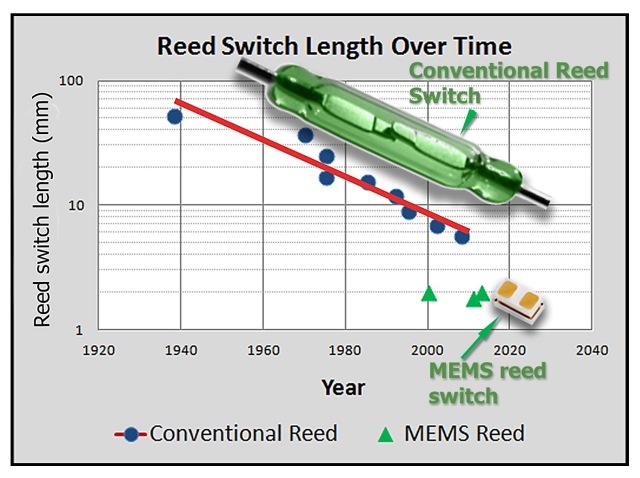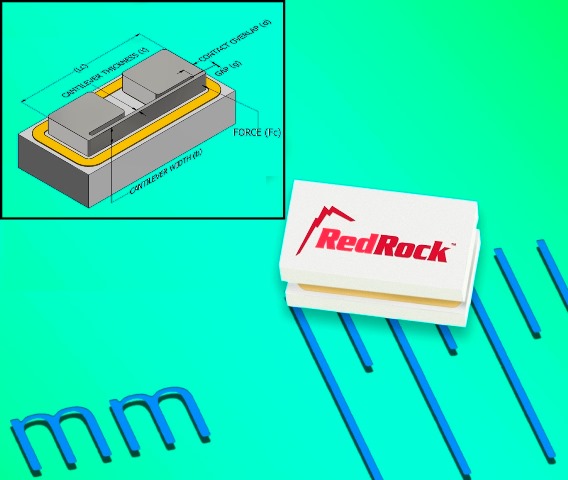The ubiquitous magnetic reed switch has a unique set of properties, including tera-ohm isolation when OFF, milliohm resistance when ON, zero power operation, around one watt hot switching capability, and almost total immunity to electrostatic discharge. However, the switches’ large size is anachronistic at a time when surface-mount components are shrinking to 0402, 0201 and even flyspeck sized 01005 (0.4 x 0.2 mm) form factors. So why not build smaller reed switches and keep up with progress? Since its invention 70 years ago, the conventional reed switch has been steadily shrinking, from a 50-mm-long glass envelope in 1938 to about 5 mm today (Fig. 1) .

Fig. 1: The graph shows the downward trend in the length of reed switches, together with the length of some recently developed MEMS reed switches. The smallest of these is Coto Technology's RedRock, which is based on HARM MEMS technology.
This graph is reminiscent of the famous Moore’s Law, which predicts the density of transistors on integrated circuits will double every two years. The size of reed switches follows a similar but less spectacular growth pattern, halving every 20 years instead of Moore’s two. However, just like Moore’s ever-shrinking transistors, reed switches are approaching a brick wall, since fundamental manufacturing and physics limitations prevent conventional reed switches from shrinking much below 5 mm.
Is it possible to break the 5-mm size barrier while retaining the reed switch’s desirable properties (zero power operation, high off-state isolation, extremely low on-resistance and hot switching capability? The answer is yes, using high-aspect-ratio microfabrication (HARM) MEMS technology; Coto Technology’s RedRock RS-A-2515 switch (Fig. 2 ) is based on this technology. (For a more detailed explanation of HARM, visit www.cotorelay.com/redrock.php.)

Fig. 2: The cantilevered HARM technology employed in RedRock provides unique advantages for many applications.
Apart from small conventional reed switches and MEMS switches, several other alternative technologies need discussion: GMR (Giant MagnetoResistive), AMR (Anisotropic MagnetoResistive), and Hall Effect switches. Unlike RedRock, these other devices are active and have the disadvantage that they require a power supply to operate them. The disadvantage of these active devices is therefore added circuit complexity and the need for PCB real estate, since they require three electrical connections instead of two: one for ground, one for the sensor signal, and one for the supply power.
Another major disadvantage is a requirement for external circuit elements such as pull-up resistors or bypass capacitors, which increase the effective size and cost of these active multicomponent-based switching solutions. Complexity is further compounded when switching milliamp-level currents or higher, since GMR and Hall devices cannot sink high currents, and external buffer circuitry is needed. A third disadvantage is susceptibility to damage from electrostatic discharge, which is not a significant risk for HARM MEMS technology.
The strengths and weaknesses of various magnetically operated switches are shown in Fig. 3. Ratings are based on published specifications and objective assessments. Of the four basic technologies for magnetic switches, only HARM MEMS technology combines zero-power operation, high-current hot-switching capability, and very small size. This performance suits the technology to numerous applications. A few examples of the types of product this technology makes feasible are “invisible” and tunable hearing aids, endoscopes the size of a pill that patients can simply swallow, insulin delivery systems, and some interesting new automotive applications.

Fig. 3: A comparison of the magnetic switching technologies available today indicates that all have strengths and weaknesses. However, HARM MEMS technology's performance make it uniquely suited to a range of applications the others cannot address.
Hearing aids
One ideal application for HARM MEMS is control functions in small portable medical devices such as hearing assistance devices (hearing aids), increasingly a baby-boomer market. The market is driven by ever-shrinking devices, since many hearing aid users prefer the aesthetics of a small, almost unnoticeable device. Hearing aids used to be controlled by mechanical switches, but as devices shrank, this became impractical, and a small magnetically operated switch became preferred for functions such as program switching and Telecoil operation because no power was needed to operate the switch. This was a good solution for bulky behind-the ear hearing aids, but as they shrank further into the ear canal itself, reed switches were too big. Zero power operation of the switch is still mandatory, since batteries have also shrunk, so a microfabricated reed switch is a perfect choice.
Capsule endoscopes
Capsule endoscopes are pill-sized devices that contain one or more video cameras and white LED “headlamps.” After a patient swallows the capsule, it takes pictures of the gastrointestinal tract and transmits them to an external monitoring system. Early warning of gastro-intestinal tract diseases is a true lifesaver, and the capsule endoscope can take pictures where a conventional colonoscope just can’t go. To keep the device down to a size that can be comfortably swallowed, the electronic circuitry must be highly miniaturized, and it must include some mechanism to start the sealed capsule up just before it is swallowed. Additionally, the power consumption of the capsule must be extremely low to minimize the size of its batteries. Active switches such as GMR or Hall-effect devices are small enough but draw current while the capsule is in storage, reducing its shelf life. In addition, they require external components and more complex circuitry than a simple two-wire reed switch. It follows that a reed switch is an ideal solution since it requires no internal power and can be magnetically triggered through the sealed shell of the capsule. Unfortunately, conventional reed switches are too big for this application, even the smallest ones currently available. Finally, the tendency of planar MEMS switches to stick shut after long periods of shelf storage also rules them out. The HARM MEMS technology microfabricated switch has the right combination of small size, zero power consumption and resistance to sticking that is needed for this application.
Insulin delivery
Insulin pumps are used to administer insulin in the treatment of diabetes, as an alternative to multiple daily syringe injections. Generally, they contain a disposable insulin reservoir, whose presence in the pump unit has to be reliably detected. Like most portable medical devices, insulin pumps are shrinking, from backpack-sized in the 1960s to modern credit-card sized pumps.
Typically, a reed switch in the pump body is triggered by a magnet attached to the reservoir. The reed switch may also detect when the insulin reservoir is running low. It is vitally important that this switching link works reliably, to ensure correct dosing or sound an alarm when the reservoir needs to be replaced. It’s also extremely important that the reed switch can’t be triggered by extraneous magnetic fields, for example from a cell phone speaker, to avoid false dosing or spurious low insulin level warnings. This is an ideal application for the HARM MEMS technology switch, not just because of its small size and zero power requirement, but also its customizable magnetic sensitivity pattern.
Automotive switching applications
At first, applications for small magnetically operated switches in motor vehicles might seem less compelling than medical device applications. After all, a motor vehicle is a much larger system with plenty of battery power, and conventional low-cost reed switches are widely use for a variety of functions such as door lock control, gear lever position sensing, and ABS systems. What use would a smaller reed switch be? It turns out there are compelling applications for smaller switches. Take the level sensor that tells the vehicle’s computer if there is sufficient fluid in the brake fluid reservoir. In most low-end and mid-range vehicles, fluid sensing is binary – a single reed switch is triggered by a float magnet in the fluid reservoir, indicating that there is either enough fluid, or there isn’t. Unfortunately, this system has significant limitations. The worst is that it does not provide a “limp home” early warning capability. If that red warning light comes on, the fluid could simply be low, in which case it might be safe to driveome carefully. Or it could be totally depleted, ready to cause complete brake failure. One answer is to use two or more reed switches in a ladder to provide a “low but not completely depleted” fluid warning. But that design has its own limitations — for one thing, it’s obviously too tall, and constrained in height by the size of the reed switches. But what if the switches were much smaller, so they could be spaced much more closely together? In that case, several switches could be installed in the same space of the conventional level sensor. That solution saves brake fluid, saves reservoir plastic, and the reduced mass decreases the carbon footprint of the vehicle while still keeping brake fluid system costs low.
Advertisement
Learn more about Coto Technology





